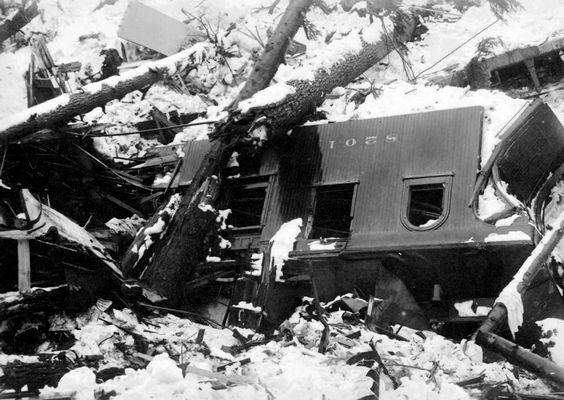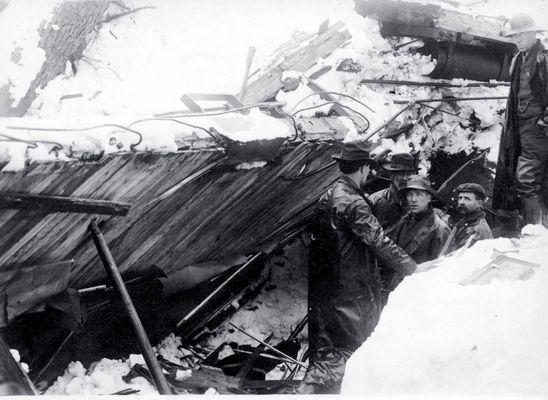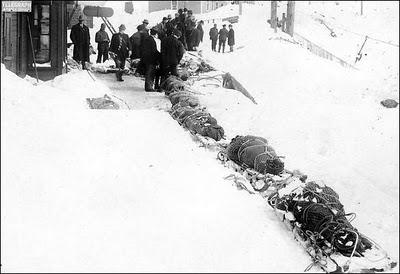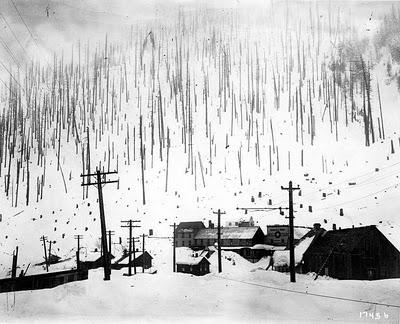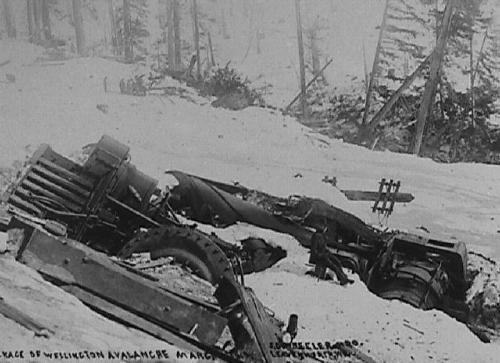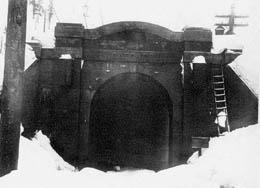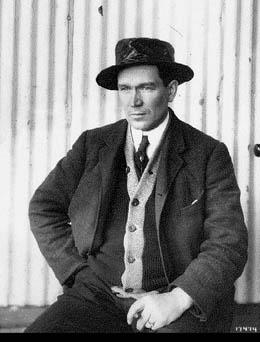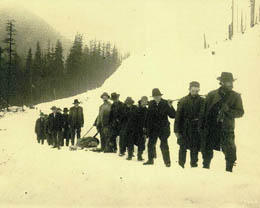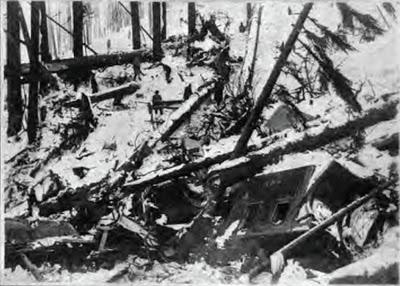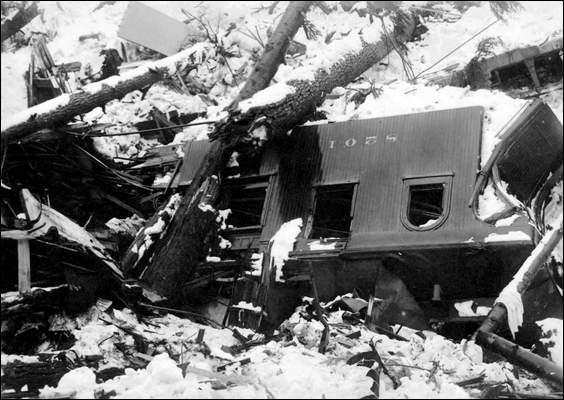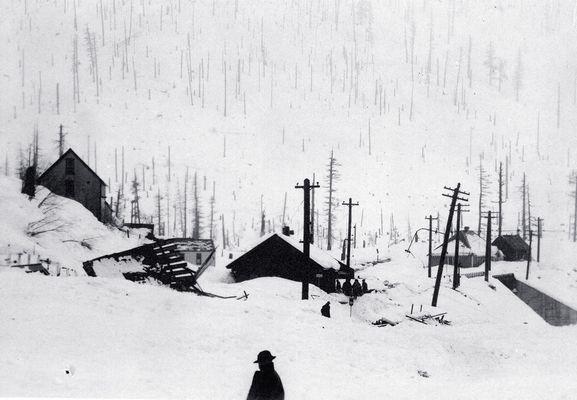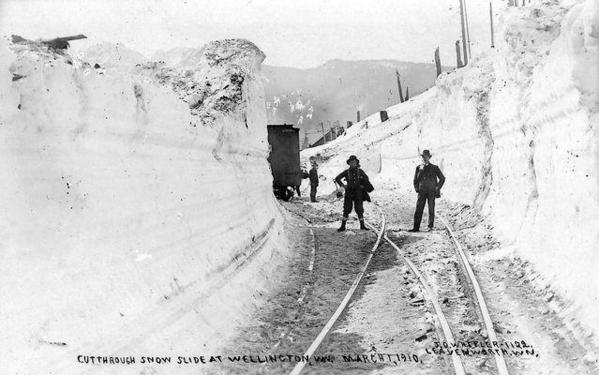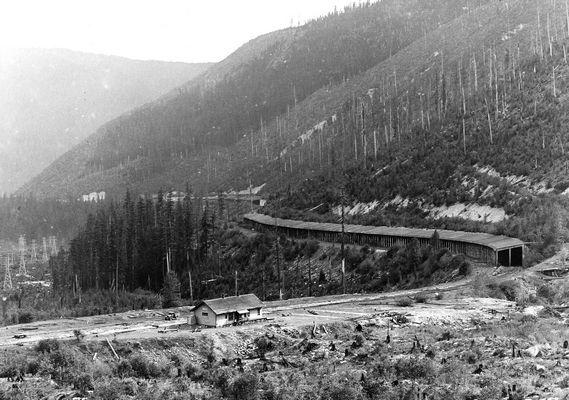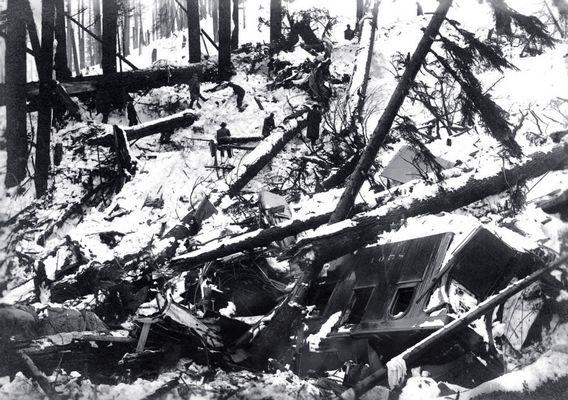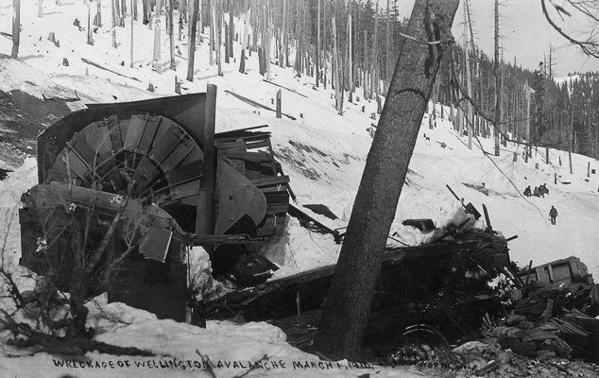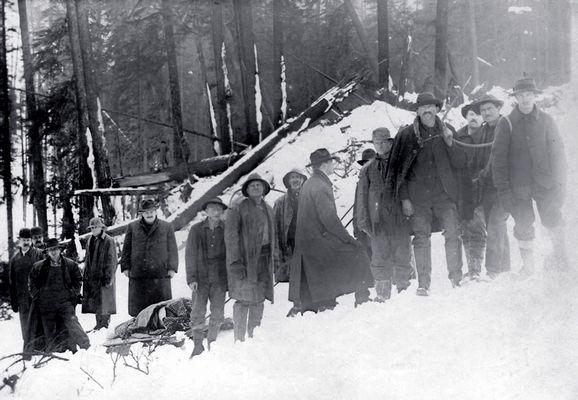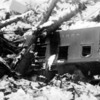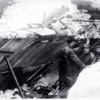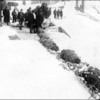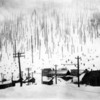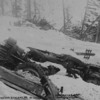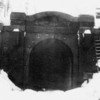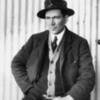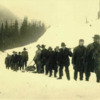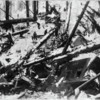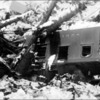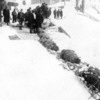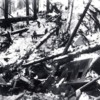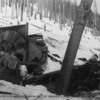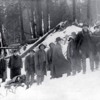The Welling Avalanche Disaster, written by John Robert Coy, January 2012
This document is respectfully dedicated entirely to the memories of all of those that perished and/or suffered serious injuries in the avalanche at Wellington, Washington.
This incident was the deadliest disaster in the history of the Great Northern (GN) Railway; and it is also the deadliest avalanche in the history of the United States of America. Wellington, in the State of Washington, was located on the original mainline of the Great Northern (GN) Railway; very near to the original Cascade tunnel.
On that fateful day, March 1st, 1910, ninety-six (96) people died. It has been reported by various sources over time that the actual death toll was much higher. It has been written that the officials of the GN intentionally attempted to keep the death toll number as low as possible for public relations purposes. Whether or not this is true is a topic for debate.
The place of Wellington was somewhat greater than a whistle stop positioned on the side of a mountain. Wellington started life as the typical railroad camp while the pacific extension was being constructed in the early 1890s. Wellington had been constructed on a section of land that was the most level in that area. This is close to where the Tye River intersects at Haskell Creek. Of course the vast majority of people who lived there were GN workers.
The largest structure in Wellington was the Bailets Hotel. This hotel also was the town’s general store and post office. Small cabins scattered about were the humble dwellings of the townspeople.
The year 1910 was an especially bad year for avalanches in the Cascade Mountain Range. It has been reported that there were dozens upon dozens of avalanches that winter. The avalanche at Wellington was by far the deadliest.
Most people believe that avalanches occur without much warning. That is absolutely not true and wasn’t true on that fateful day. Conditions that create a high risk for avalanches were known in that period of time.
On the 21st day of February in 1910, the Great Northern Railway had information that a huge/severe blizzard was forecast. The two trains that were eventually swept off the tracks at Wellington had departed from Spokane on the 22nd. Both of those trains arrived in Leavenworth, Washington, later on that same night.
It was at that point that James H. O'Neill, who was the railroad Superintendent of the Cascade Division of the Great Northern Railroad, had to evaluate whether or not to re-route the trains because of the threat of a major storm and possible avalanches.
O’Neill concluded that the storm wouldn’t be as bad as predicted and allowed these trains to continue. That was a gross error in judgment on his part and set the cycle of disaster in motion.
Before either of these trains went very far, an avalanche occurred ahead which obstructed their path. Therefore, these trains were delayed thirty-six (36) hours until rotary snowplows could open the line. The trains once again began their journey and arrived at and were again delayed once more at their fateful destination of Wellington which is located very near to Stevens Pass which was absolutely one of the most vulnerable points for snow fall/avalanches anywhere along the line of the GN.
On Wednesday morning, passengers aboard awoke to discover that they were still high in the mountains nowhere near to their final destination at Seattle. They could also see the other train, the fast mail train, stationary, adjacent to their train.
It was at that point these people aboard began to become very concerned. The mountainside high above their heads was packed with the heavy falling snow. Passengers relayed their concerns to the crew and wanted to know what was being done to protect them.
The crew advised the people that they were in the safest place that they could be. There were those who wanted their train to be placed into the tunnel. The crew told those people that there would be no heat on the train if the train was placed into the tunnel because the engine’s exhaust would overcome and eventually kill them.
Others suggested moving their train to cover under the snow shed and were advised that the entire train couldn’t fit under this snow shed. While others debated, wondered and worried, the temperature was climbing making the snow heavier and wetter minute by minute. Conditions were ripe for an avalanche.
Unbeknownst to all of these stranded people, way back at Cascade Station, an avalanche struck right where both of these trains had been earlier in their respective trips. Therefore, if the passenger train had remained at Cascade, the passengers would have in all likelihood been killed there days before. The two trains were both completely snow bound in Wellington for four days. Supplies were dwindling swiftly; including food. All the while the snow kept dumping down from the skies. Passengers, over time, could begin to hear snow sliding down from the mountains in the distance. That only served to heighten for all the level of anxiety and fear.
On Sunday, February 27, several passengers planned to evacuate via foot from Wellington. They were ill prepared, but growing more fearful and desperate. The crew warned the passengers that it was much too dangerous to attempt; yet some people still elected to go ahead anyway and were fortunate enough to make it out alive. When word returned of that first group’s success, those behind began to plan as well.
On that same Sunday morning the 27th, the passengers gathered at a makeshift church service. Patience was the sermon’s focus. The Pastor onboard the train certainly didn’t have to work hard to come up with a relevant topic that day. That certainly would be practicing what you preach put into action.
Meanwhile, James H. O'Neill was making plans to hike out himself to get assistance and supplies for everyone. He gathered some others to accompany him. The man leading this courageous group had just walked past a stranded rotary snow plow when the group’s luck ran out immediately. There was a thunderous sound of snow sliding down the mountainside and the leader of the group was whisked away and buried alive in the snow. He was never seen again by the group. This tragedy reinforced O'Neill's stance that the best course of action was to remain in Wellington.
Ironically, later another group departed Wellington via foot and discovered the man, the leader of the other pack, at a lodge many miles away. They were able to send word back to Wellington that they had located the man and refuge. However, they also sternly warned against others attempting it because they nearly froze to death in the process.
At a little bit after 1 A.M., on March the 1st, 1910, a violent thunderstorm, with multiple lightening strikes was in progress when the huge, estimated to be one-half mile wide, avalanche came down the mountainside and swept the trains, with many people on board, into the canyon below. Mixed into the avalanche were large trees, boulders and various other debris that created even more devastation and added impact to any object, including these two trains, in its path.
Immediately afterwards those not swept away in the avalanche raced to the rescue of those onboard who were hundreds of feet down the mountainside scattered among splintered buildings, including a water tank, cabins and pulverized train cars. That night twenty-three (23) people were pulled alive from the snow and wreckage. These people were exceptionally fortunate and highly blessed to be still alive.
As the morning light broke, and the storm subsided, the recovery effort had the stressful task of continuing to attempt to seek, locate and assist survivors. Many bodies had literally been ripped to shreds by the awesome force of the avalanche. As anyone may imagine the mental anguish and horrifying scenes laid before these people were just too much for many to handle.
Almost 12 hours had elapsed when the people believed that they had rescued the last survivor. However, someone kept hearing a very muffled and faint sound coming deep from within the snow. The people immediately began a frenzied effort to reach the sound. In the process they uncovered yet another dead body, but kept on digging. At last they found the source! Ida Starrett was the last survivor rescued alive at Wellington. Mrs. Starrett was a young widowed mother from Spokane. Ironically, her husband, a Great Northern freight conductor, had been killed just weeks before at the railroad's main yards in Hillyard, Washington. She had just settled his estate and was moving with her elderly parents to Canada to make a fresh start. In her care were her three children: nine-year-old Lillian, seven-year-old Raymond, and an infant boy, Francis. Only She, her mother and Raymond survived.
Over the course of the next several days there were a number of news stories circulating and reporting on the tragedy; some even had the death toll as high as 118. The injured were transported to Wenatchee. The bodies of the dead were placed onto toboggans; and taken down the mountainside; eventually being placed onto trains. Among the dead were: 35 passengers, and 61 employees. It wasn’t until July of that year, four months later, that the last bodies could be located and recovered.
The avalanche spared the largest building in Wellington: the Bailets Hotel; however the train depot was wiped-out, along with the water tower and some cabins. There were a total of 120 people on the trains when the avalanche hit and 96 of them died. The way the avalanche came down some of the railcars were thrown skyward and landed on top of the avalanche rather than being buried. The people in those cars had a far greater opportunity for survival.
Sadly, at that moment in time, railroads didn’t keep official lists of passengers. That made attempting to account for individuals a mighty challenge.
There was a story written about a man named Joseph Benier who was identified by several people as being one of the Wellington dead. Mr. Benier appeared in person at a funeral parlor and said: “My friends say that you have me dead downstairs. I want to say that I am the livest man in town.”
Time elapsed but the tragedy never faded from view as the GN may have hoped. The town of Wellington was renamed: “Tye” in October 1910. This was done without notice or fanfare. The commonly accepted reason for the name change was most likely because of the unpleasant memories immediately resurfaced at the mention of Wellington.
Also relatively shortly after the disaster, the GN embarked on the installation of concrete snow sheds to shelter more of the tracks in this vulnerable area. By 1930, the second much longer Cascade Tunnel opened and Wellington/Tye ceased to exist.
More than sixty (60) years later, a group of volunteers planned the creation of a rail trail though the Wellington area. The trail is named the “IRON GOAT TRAIL.” This trail runs from a point near Scenic through Stevens Pass including views of the original tunnel.
At the trailhead, the Washington State Department of Transportation has an interpretive center stationed inside an old caboose. Because of the hard work of many groups and individuals, the area of the disaster will be accessible. The memories of those who perished shall remain alive because of the dedicated volunteers.
May God rest his peace on the souls of those lost and their loved ones in this most tragic event!
Source of List Below: Ruby El Hult; Northwest Disasters
VICTIM LISTS-WELLINGTON AVALANCHE
The Dead
PASSENGERS
1. Richard M. Barnhart, 40, attorney from Spokane. Survived by wife and small child.
2. George L. Beck, 40, from Marcus, Wash.
3. Ella A.Beck, 30, wife of George.
4. Erma Beck, age 4, child of George and Ella
5. Harriet Beck, age 6, child of George and Ella
6. Leonard Beck, age 2, child of George and Ella
7. R. H. Bethel, 44, contracting and consulting engineer of firm of Bethel & Downey, Seattle. Survived by wife.
8. Albert Boles, 34, from Moberly, Ontario, Canada. Survived by brother Edward W. Boles.
9. John Brockman, 45, rancher from Waterville, Wash. Survived by brother of the same name.
10. H. D. Chantrell, 50, customs officer at Blaine, Wash. Survived by brother, Spokane; son, Seattle.
11. Alex Chisholm, 60, Rossland, B C. Survived by wife.
12. Solomon Cohen, 50, Everett, Wash. Survived by wife and five children.
13. Mrs. M. A. (Sarah Jane) Covington, 69. Survived by husband and married children.
14. George F. Davis, 35, Seattle, motorman on Seattle, Renton & Southern line.
15. Thelma Davis, 3, daughter of George F. Davis.
16. Charles S. Eltinge, 50, treasurer of Pacific Coast Pipe Company, Seattle. Survived by wife and five children, Spokane.
17. George A. Heron, 26, from Ireland, working as sawmill hand in Moyie, B. C.
18. Mrs. M. L. (Libby) Latsch, 30, head of Northwestern Sales Company, Seattle. Survived by husband and small child.
19. Sam Lee, an American, age about 25. Identified by tattoos.
20. Edgar Lemman, 47, attorney from Hunters, Wash. Survived by daughter, Hunters, and parents, Ritzville, Wash.
21. Ada Lemman, 39, wife of Edgar Lemman.
22. John Mackie, 24, from Ireland. Friend and working companion of Heron and Monroe.
23. Nellie Sharp McGirl, 26, a writer. Survived by husband in California, father and sisters in Midwest.
24. James McNeney, 59, Seattle attorney and former judge. Survived by wife.
25. Albert G. Mahler, 55, Seattle real estate dealer. Survived by wife and thirteen-year-old son.
26. Bert Matthews, 37, traveling salesman from Cincinnati, Ohio.
27. William May, 54, Chemainus, B. C. Father of Mrs. Starrett.
28. James Monroe, 26, from Ireland. Friend and working companion of Heron and Mackie.
29. Catherine O'Reilly, 26, nurse from Sacred Heart Hospital, Spokane.
30. Lillian Starrett, age 9.
31. Francis Starrett, baby eight months old.
32. Benjamin G. Thompson, Rossland, B. C. Survived by wife.
33. Reverend James M. Thomson, 57, minister, Bellingham. Survived by wife and grown sons.
34. Edward W. Topping, 29, traveling representative for Safety Door Hanger Company, Ashland, Ohio. Survived by father and small son.
35. J. R. Vail, 60, sheepherder from Trinidad, Wash.
TRAINMEN AND POSTAL EMPLOYEES
36. Lee J. Ahern, age 25, mail weigher on Train No. 25. Survived by parents, Spokane, Wash.
37. Grover W. Begle, 24, express messenger on Train No. 25. Survived by wife, Seattle, Wash.
38. Earl Edgar Bennington, 29, fireman. From Kingston, Ontario, Canada.
39. John Bjart, about 40, laborer.
40. Arthur Reed Blackburn, 33, trainmaster. Survived by wife and week-old baby in Everett, Wash.
41. Richard C. Bogart, 36, mail clerk on Train No. 27. Survived by parents, brother and sister, Spokane.
42. Fred Bohn, 20, mail weigher Train No. 27. From Palouse, Wash.
43. William E. Bovee, 26, brakeman. Survived by father, Renton, Wash.
44. Peter Bruno, 40, Italian laborer.
45. Alex C. (Ed) Campbell, 28, rotary conductor. Perished in cabin. Survived by wife, Bellingham, Wash.
46. J. O. Carroll, engineer. Survived by wife, Everett.
47. G. Christy, laborer.
48. William Corcoran, 45, engine watchman.
49. William N. Dorety, brakeman.
50. Anthony John Dougherty, 27, brakeman. From Waverly, Minnesota.
51. H. J. Drehl, 40, express messenger Train No. 27. From West Alexandria, Ohio.
52. William A. Duncan, 45, porter. Survived by brother, Seattle.
53. Archie R. Dupy, 23, brakeman. Survived by family in Waynoka, Oklahoma.
54. Earl Fisher, 19, either a fireman or laborer. Home reported as Rossland, B. C.
55. John D. Fox, 42, mail clerk in charge of Train No. 27. Survived by wife and three children, Seattle.
56. Luigi Cimmarusti, 45, Italian laborer. From Spokane.
57. Donald Cameron Gilman, 33, electrician. Killed in cabin. Survived by parents, Santa Barbara, Calif.
58. Mike Guglielmo, 23, Italian laborer. Survived by brother, Spokane.
59. M. Milton Hicks, 25, brakeman. Survived by father, Sedro-Woolley, Wash.
60. George Hoefer, 28, mail clerk Train No. 27. Survived by wife, Spokane.
61. Benjamin F. Jarnagan, 31, engineer. Survived by father, Seattle.
62. G. R. Jenks, fireman. Unmarried: lived in Everett.
63. Charles William Jennison, 28, brakeman. From Zimmerman, Minnesota.
64. Sidney H. Jones, 25, fireman. Survived by wife, Everett.
65. John Edward Kelly, 23, brakeman. Survived by father, Everett.
66. William Kenzal, 38, brakeman. Survived by brother, Rochester, New York.
67. Charles F. LaDu, 26, mail clerk Train No. 27. Survived by sister, Sidney, New York.
68. Gus Leibert, 25, laborer.
69. J. Liberati, laborer.
70. Stephen Ernest (Ed) Lindsay, 33, rotary conductor. Survived by father and brother, Seattle.
71. Earl R. Longcoy, 19, secretary to Division Superintendent J. H. O'Neill. Survived by mother and sister, just arrived in Everett from Wisconsin.
72. Francis S. Martin, engineer Train No. 25. Survived by wife and children, Spokane.
73. Archibald McDonald, fireman. Body found in springtime, 1910.
74. Peter Nino, 37, engine watcher.
75. T. L. Osborne, engineer. Survived by family, Leavenworth, Wash.
76. Harry Otto Partridge, 35, fireman. Survived by mother, Biloxi, Mississippi.
77. John K. Parzybok, 24, rotary conductor. Survived by bride of six months, Everett.
78. Joseph L. Pettit, conductor Train No. 25. Survived by wife and children, Everett.
79. Antonio Porlowlino, 35, laborer.
80. William E. Raycroft, 31, brakeman. Survived by wife and mother, Everett.
81. L. Ross, 25, fireman. From Paintsville, Kentucky.
82. Carl Smith, 50, laborer.
83. Andrew Stohmier, 30, brakeman. Killed in cabin.
84. Vasily Suterin, about 35, Russian laborer.
85. Giovanni Tosti, 30, Italian laborer.
86. Hiram Towslee, 36, mail clerk in charge of mail car, Train No. 25. Survived by wife, Fort Steilacoom, Wash.
87. John C. Tucker, 37, mail clerk, Train No. 27. Survived by wife and father, Spokane.
88. Lewis George Walker, 53, steward O'Neill's private car. Survived by wife and grandmother, Everett.
89. Julian E. Wells, 19, brakeman. Lived in Seattle.
90. G. R. Yerks, 24, fireman. From Fielding, Michigan.
91. Unidentified laborer #1
92. Unidentified laborer #2
93. Unidentified laborer #3
94. Unidentified laborer #4
95. Unidentified laborer #5
96. Unidentified laborer #6
The Survivors
1. John Gray, from Nooksack, Wash. Broken right leg sustained in a prior accident. Rescued from snow. Leg rebroken and minor injuries.
2. Anna Gray, wife of John Gray. Rescued from snow. Fairly severe injuries.
3. Varden Gray, eighteen-month-old son of John and Anna Gray. Rescued from snow. Fairly severe injuries.
4. R. M. Laville, electrician from Missoula, Montana. Rescued. Minor injuries.
5. Mrs. William May, Chemainus, B. C. Rescued. Minor injuries. (Mother of Mrs. Starrett.)
6. Mrs. Ida Starrett. Rescued from snow after an eleven hour incarceration. Serious injuries.
7. Raymond Starrett, age 7. Fairly severe injuries.
8. Henry H. White, salesman American Paper Company. Fairly serious injuries.
PASSENGERS AND EMPLOYEES WHO WALKED TO SCENIC PRIOR TO AVALANCHE
Sunday, February 27, 1910
9. John Merritt, attorney, Spokane, Wash.
10. Lewis C. Jesseph, attorney, Colville, Wash. Milton Horn. 18, Wenatchee, Wash. Edward W. Rea.
11. George Loveberry, proprietor, hay and feed store, Georgetown, Wash.
Monday, February 28, 1911
12. John Rogers, real estate man, Seattle.
13. E. A. Sperber, Spokane.
14. R. McKnight.
15. Charles Young.
16. Frank Ritter, 18, Bellingham.
17. E. W. Boles, brother of Albert Boles, killed in avalanche.
18. Samuel Field, from Alaska.
Included in this party on Monday were four railroad employees:
Conductor J. L. Pettit, Everett;
19. H. L. Mertz, Hillyard;
20. Angus Van Larke, Seattle; and
21. Guiseppe Dinatale, a laborer.
Conductor Pettit returned to the train at Wellington and was killed in the avalanche.
Train Employee Survivors
22. Lucius Anderson, porter on sleeping car Winnipeg. Minor injuries.
23. Samuel A. Bates, fireman. Rescued after being trapped for six hours beneath an engine. Minor injuries.
24. Ira Clary, rotary conductor. Rescued from snow. Minor injuries.
25. E. S. Duncan, brakeman. Extricated from wreckage. Minor injuries.
26. Ray Forsyth, section laborer, sleeping on passenger car. Minor injuries.
27. William Harrington, trainmaster. Thrown clear of wreckage. Fairly severe injuries.
28. Alfred B. Hensel, mail clerk Train No. 27. Extricated himself from wreckage. Fairly severe injuries.
29. J. L. Kerlee, brakeman. Released by others from beneath an engine. Minor injuries.
30. George (Bat) Nelson, fireman. Minor injuries.
31. Homer E. Purcell, rotary conductor. Minor injuries. Thrown clear of wreckage.
32. Ross Phillips, brakeman. Rescued. Fairly severe injuries.
33. Adolph Smith, porter from sleeper Similkameen. Rescued. Minor injuries.
34. Irving Tegtmeier, master mechanic. Rescued. Fairly severe injuries.
35. M. O. White, rotary conductor. Rescued. Minor injuries.
References:
Northern Disaster - Avalanche and Fire, by Ruby El Hult. Binford and Mort, Portland, Oregon. ISBN 0-8323-0224-4. Copyright 1960
Gary, Krist, The White Cascade: The Great Northern Railway Disaster and America's Deadliest Avalanche, Holt, 2007
T. Gary Sherman, Conquest and Catastrophe, The Triumph and Tragedy of the Great Northern Railway Through Stevens Pass, AuthorHouse, 2004
Don Moody, America's Worst Train Disaster, by Don Moody. Abigue Publications, Plano, Texas
The Seattle Times: Originally published February 27, 2010
George Tibbits, Associated Press Writer, Take an eerie trip back in time on Washington's Iron Goat Trail, February 10, 2012 in the USA Today
WEBSITES:
IRON GOAT TRAIL
January 26, 2003, “ Train Disaster at Wellington Kills 96 on March 1, 1910 ”, History Link.org
Kelly, Robert E. 1998, “The Wellington Avalanche”, NC Network.net
Washington State Historical Society Achieves On-Line




